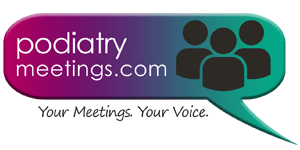As you know, many of the conferences and seminars in the podiatric industry are run by organizations or associations. Additionally, associations are also often run by a rotating group of members, elected to fill a position for 1 or 2 years. The quick turnaround of individuals in leadership positions in these associations and organizations can make it difficult to “copy and paste” from one year to the next.
With new leadership comes new ideas to run your organization’s meeting. While new ideas are highly encouraged and often lead to positive change; there are certain meeting aspects that need to be “copied and pasted” from year to year; and hitting those marks can become less efficient given the re-training of new people every couple of years. In addition to filling a leadership role, most members who are involved in helping with meeting planning and implementation are also busy, practicing physicians. This can create even more stress and distraction from the goals of the main event.
One way to ensure a smooth transition from one leadership team to the next, is to outsource the tasks associated with the annual conference. This ensures that each yearly event maintains the same basic flow and strengthens crucial relationships (like those with sponsors and faculty) year after year.
Deciding to outsource a project can be a bit of an overwhelming decision. You might find yourself drowning in questions like:
-
How do you find the right person or company?
-
How do you get started?
-
What tasks do you delegate?
-
How do you manage efficient communication?
So, let’s break it down.
Finding the right person or company.
Look to your network. Ask others within your organization if they know of anyone that can take over conference related tasks. If no names come up there, broaden your search to your peers within the podiatric industry. Do they have anyone that comes to mind? Be sure you select someone that is familiar with the podiatric industry as it does have a fair amount of “quirks”. If your annual conference offers continuing education credit, look for someone with experience in CPME standards for CME activities.
Getting started.
Ask yourself which you need to delegate. The first thing is to have a “Discovery Call” with your selected third-party where you provide some background about your organization, it’s conference and any struggles that come to mind. Your consultant will have questions as well and this all leads to a conversation that gives a birds-eye view of what is needed and where the “pain points” are.
I always suggest starting with the task on your plate that you’ve been putting off, or that you consider to be your most “pain-in-the-butt” task. Once this is complete, it will give you a sense of accomplishment and it will have allowed the consultant an opportunity to see the systems and processes already in place within your organization and perhaps to offer recommendations for improvements.
Moving forward, be sure to have clearly identified roles and responsibilities. You want to be sure you never have more than one person working on the same action item. It’s just not efficient and leads to confusion within your organization.
Managing efficient communication.
In addition to clearly defining roles and responsibilities, discuss expectations regarding method and frequency of communication. Will there be weekly update calls or emails? Will there be daily updates for specific projects? When you send an email to your consultant, how long will it be before they will respond? Who within your organization needs to be included on items related to: site selection and logistics, speaker selection and agenda, exhibits and sponsors?
Be as clear as possible from the beginning and adjust as necessary. Typically, when you first get started with a consultant, they will wait to receive guidance from you and let you set the pace for level of involvement.
Finally, you must decide if outsourcing is a good fit for your organization and its goals. Therefore, it’s critical to break down the pros and cons so you can have a balanced view and can make the best decision.
Pros and Cons of Outsourcing
Pros
-
Allows the organization to focus on the core aspects of their mission while delegating specialized tasks to an expert.
-
Eliminates the cost of any “wasted time” because consultants typically charge by the hour and only bill when they are actively working on a project.
-
Ensures a seamless transition from year to year.
-
Carries both positive and negative feedback into future years for continuous improvement.
Cons
-
Communication can be difficult if standards are not in place.
-
Some organization leaders will find it difficult to not have direct access to a consultant at all times.
Examples of Tasks to Outsource Related to Meeting Planning
-
Site selection
-
Marketing (digital and print strategy)
-
Graphic Design
-
Print and promotional materials – selection, design, ordering
-
CECH/CME related requirements
-
On-Site assistance at the registration table, as a runner, exhibitor liaison, etc
-
Managing exhibitors and sponsors
-
Registration process and badge printing
-
Speaker Management
-
And much, much more

Leave A Comment
You must be logged in to post a comment.